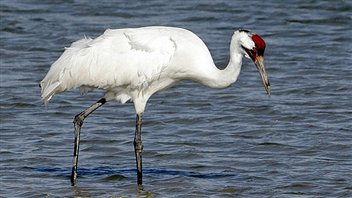Biologists are quietly optimistic about the numbers of whooping cranes nesting this year in Wood Buffalo National Park situated in northern Alberta and into the Northwest Territories.
The Whooping Crane all but disappeared by the 1940’s with less than 20 birds in total remaining. Listed as endangered in 2000, legal protection, dedicated conservation and zoo breeding programmes have increased the numbers from the brink
The annual spring survey of nesting birds has been taking place for some four decades This year’s survey has just been completed and a record of 82 nests were found, up from 74 last year.
The WBNP flock is the only seemingly self-sustaining flock of Whooping Cranes in the world with the numbers up to around 300 birds. However, to be truly self-sustaining, ie requiring no human help, it’s felt that the flock must have at least 1,000 individual birds and 250 reproductive pairs before the species can be considered for down-listing under the Endangered Species Act.

Mark Bidwell, a “species-at-risk” biologist with the Canadian Wildlife Service says the number of nests indicates the number of birds are increasing. He noted also that some nests were found outside the park, “This is actually quite an exciting result because it highlights the range expansion that we have observed in recent years,” Bidwell said. “Cranes have been expanding their territories into new areas within the park but also outside the park. That range expansion means we’re seeing cranes using bigger areas and more extensive areas than we have seen before.”
The Aransas- Wood Buffalo flock migrate annually from wintering in Aransas, Texas, to the Canadian Park for the summer, where eggs are laid.
At almost 45,000 square kilometres, it is one of the largest protected parks in the world. It was established in 1922 to protect the last remaining herds of bison in northern Canada, but is also home to the largest migrating population of endangered Whooping Cranes.
In late July, biologists will return to the sites to check on the productivity of the nesting pairs in a survey of chicks and how many have become fledglings and are likely to be able to survive the autumn migration to their wintering grounds in Texas.







For reasons beyond our control, and for an undetermined period of time, our comment section is now closed. However, our social networks remain open to your contributions.